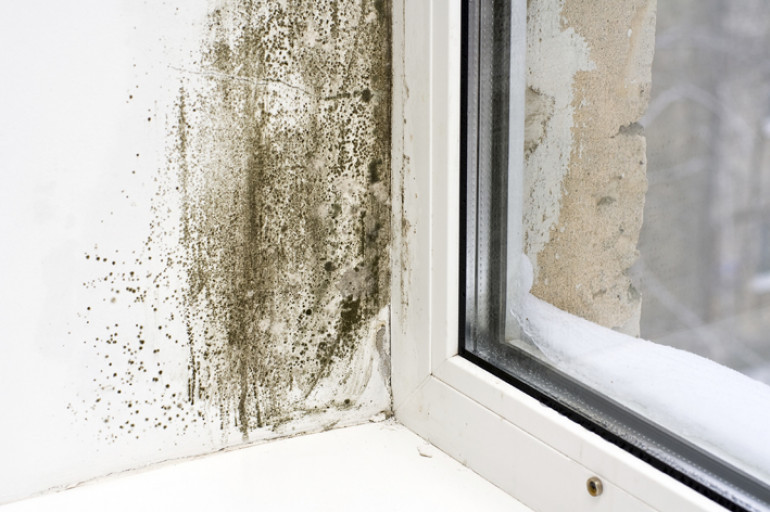Dampness and Mould
No one wants to live in a damp home. Damp can cause mould on walls and furniture and cause wooden window frames to rot. It's also unhealthy. Damp is invariably caused by condensation. This can lead to a growth in mould that appears as a cloud of little black dots.

Condensation occurs when moist air comes into contact with a colder surface like a wall, window, mirror etc. The air cannot hold the moisture and tiny drops of water appear. It also occurs in places the air is still, like the corners of rooms, behind furniture or inside wardrobes.
Below are some tips to help you ensure mould and dampness does not occur in your home. Should you have concerns about mould growth in your property, please contact the Housing Team on 01592 721 917 or housing@orevalleyha.org.uk who will be able to offer assistance.
1. Reduce Moisture
Condensation is caused by excess moisture in the air hitting colder surfaces, in order to reduce the likelihood of it appearing, try to reduce moisture levels at home.
When you cook, put a lid on pans and keep the kitchen well ventilated by using an extractor fan or keeping the window open. If windows are difficult to open please let us know.
Similarly, when you take a bath or shower, keep the room well ventilated to allow steaming air to escape through a window or vent. When filling the bath always put the cold water in first as this will reduce the amount of steam generated by up to 90%.
To stop condensation forming, bathroom and kitchen windows should be opened, and extractor fans turned on. Try to keep the bathroom and kitchen door shut as much as possible when these rooms are in use, so that moisture does not escape into other parts of your home.
Wet surfaces attract moisture, so wipe them down to get rid of the excess water. Dry off windows, shower screens and kitchen splashbacks to remove moisture when it forms.
2. Dry clothes outside
During the winter, it is tempting to dry wet clothes indoors on radiators but doing so creates higher moisture levels in the air, contributing to condensation. If you are drying clothes indoors please be sure to ventilate as much as possible.
Try to hang your washing outdoors as much as possible during winter. If you use a tumble dryer to dry clothes, make sure that this is vented to the outside to allow moisture to escape.
3. Allow Air to circulate
Allow air to circulate in parts of the home where it may otherwise remain stagnant. Regularly open cupboards, drawers, and wardrobes, for instance, to give them an airing and do not overfill them. Create a gap between furniture and walls to stop air from getting trapped and causing condensation to form.
4. Effective Insulation
OVHA will ensure that your home is properly insulated and that it has an effective damp-proof course. Seal up or report any cracks or gaps in structures, and report any damage to gutters or roofing, sooner rather than later. If you think that your home does not have sufficient insulation please let us know so that we can check.
5. Adequate Heating
Adequately heating your home can help to reduce condensation and damp, so keep temperature levels consistent, especially in those rooms that you may not use often. A heating thermostat can be useful for this. Avoid using Calor Gas or other fuel burning heaters in your home as these may create additional moisture.
6. Home Ventilation
Keep window vents open to allow air to circulate and moisture to escape. Also use extractor fans provided in kitchens and bathrooms, we may consider other home ventilation systems, if damp or condensation is a particular problem. Our homes are becoming increasingly airtight and less draughty and the need to ventilate is becoming more important in order to reduce condensation and mould and improve our health.
7. Removing Mould
Mix up a solution of 2 parts bleach with 10 parts water in a spray bottle (an empty cleaning spray bottle will do) and spray the bleach water onto the walls to kill the mould. Leave for 10 minutes and wipe away with a damp cloth.
Or if you prefer not to use bleach, combine a teaspoon of bicarbonate of soda with water in a spray bottle and shake until it has dissolved. Spray it directly onto the mould and leave for a few minutes. Use a scrubbing brush or sponge to remove the mould, then wipe the solution off with water. Spray the solution on the area again and let it dry.
Be sure to always stand on a secure platform eg. a chair or step ladder when working at ceiling height, understand your own limitations and seek assistance if needed. Further information about how to remove mould from walls and ceilings is available here.
8. Decoration
When decorating bathrooms and kitchens use specialist emulsion paints specifically designed for bathrooms and kitchens, which helps to reduce the growth of mould, especially on ceilings.
.png)